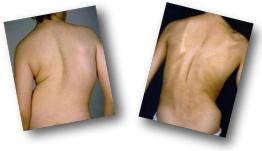Scoliosis is a side-to-side curvature of a normally straight spine. Scoliosis affects approximately 3% of the population or 12 million people worldwide. Left untreated, this unhealthy curve can worsen and cause deformity, respiratory problems, cardiac problems, digestive problems, and debilitating pain. A rotation of the vertebra and the rib cage usually accompanies this unhealthy curve. The majority of Scoliosis patients are diagnosed between ages of 12 and 16, although there are many younger children and adults who suffer from the condition as well.

What causes Scoliosis?
Most cases of Scoliosis are classified as idiopathic, meaning that is no known cause, however recent research now points to a genetic link. Other causes include injury, trauma and other contributing diseases.
Adolescent Idiopathic Scoliosis (AIS) occurs after age 10 and is most common in females but can occur in males. Juvenile Idiopathic Scoliosis (JIS) typically affects patients ranging from age 3 to 10 years old. Early Onset Scoliosis (EOS) affects patients age 3 or younger, and although the condition is rare, it can severely interfere with lung function and growth.
Scoliosis is a progressive disease, which can continue into maturity. Although most progression tends to slow or halt at skeletal maturity, it is not uncommon to see worsening in adulthood. As such, it is a disease that must be monitored aggressively and treated as early as possible, preferably before the curve reaches 30 degrees.
No matter what the type or cause of Scoliosis, it is important to get an accurate diagnosis. There are a few structural shifts in the spine that can mimick scoliosis such as a shift to the side of the torso due to an anatomically short leg. While these situation still warrant attention, the treatment will vary.
Indications of Scoliosis
Scoliosis may be slight or significant, and may include the lumbar, thoracic or thoracolumbar regions of the spine.
Noticeable changes often include:
|  |
Since many early degenerative changes are shown in younger patients, adults often have severely advanced degenerative changes in the spine if Scoliosis is present for long periods. If untreated, some severe Scoliotic deformations may have long term consequence on locomotion (pain and mobility limitation), aesthetic (hunchback aspect and short trunk), and vital functions (respiratory and cardiac pathology) in very severe situations.